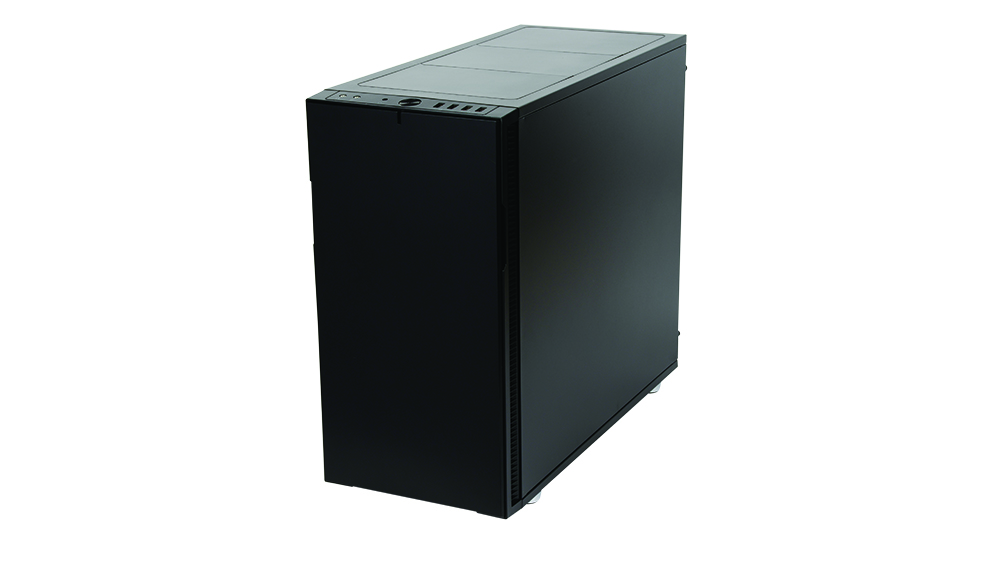InterPro IPW-SL review
An excellent choice for fast modelling and image editing, with oodles of storage in a keenly priced package


The InterPro IPW-SL has a lot going for it as a modelling and image-editing workstation. The price is also keen for the spec, particularly with the generous storage: this is our top choice if your focus is on the kind of applications where it’s strong.
-
+
Excellent performance for design tasks; Tidy internal cavity; Good value;
-
-
Only quad-core; disk write speeds are a little behind competitors;

The IPW-SL has the honour of being the fastest workstation at least in terms of processor speed we've tested for a while. This turn of pace is built on Intel's Skylake chips rather than its predecessor Haswell, with InterPro taking advantage of the extra headroom afforded by the K version of the Intel Core i7-6700. It was already fast at 4GHz, but InterPro boosted the clock to 4.6GHz with the help of Corsair H80i watercooling.
InterPro partners the CPU with 32GB of 2,666MHz DDR4 SDRAM, although this takes all four DIMM slots so there won't be any upgrade option without substitution. Since the Intel Core i7-6700K has a dual-channel memory controller, rather than the quad-core controllers in some six-core CPUs, there's no need to add DIMMs in multiples of four. We'd have preferred two 16GB modules.
Like other manufacturers, InterPro opts for Nvidia's Quadro M4000 graphics, which currently hits the sweet spot between price and performance for high-end professional 3D acceleration. Storage is generous, with a 400GB Intel 750 Series PCI Express SSD included for the OS and apps, while a capacious 4TB WD Black 7,200rpm mechanical hard disk takes one of the eight SATA ports.
The Intel SSD offers fast sustained reads, but disk-specific benchmarks showed writing is a little behind most, while the hard disk also proved relatively slow. But the key word here is "relatively" this remains a fast storage system compared to what it's likely to replace. The optical drive is a Blu-ray writer, too, so can be used for backing up large amounts of project work.
InterPro uses the Fractal Design Define R5 chassis, but you'll find no complaints from us: it's an excellent choice, not least due to its solid construction. The side panel is secured by a catch as well as screws, so you can leave the latter off if you regularly swap components. It has eight tool-free hard disk bays, and with seven still free, there's plenty of room to expand. Plus, with the 650W version of Corsair's CS Series Modular 80 Plus power supply in place, the internal wiring clutter is kept to a minimum because you only need to connect the power cables you're actually using.
Thanks to the extra clock speed, the InterPro achieved the best Maxon Cinebench R15 rendering score of any quad-core Skylake workstation in recent memory; a great result, but note that many six-core Haswells are faster still. The LuxMark and Bunkspeed rendering tests told a similar story. It was also among the most accomplished in our image-editing test, although video encoding and multitasking brought the overall benchmark score down.
Scores in SPECviewperf 12 were mostly as expected for a system sporting a Quadro M4000, but there were standout areas. In particular, the result of 72 in the maya-04 viewset will please 3D animators, and 116 in the SolidWorks sw-03 viewset will tempt product designers.
The InterPro IPW-SL has a lot going for it as a modelling and image-editing workstation. Although its rendering and video encoding are behind six-core alternatives, if your main need is design, this system offers some of the best overall performance around. The price is also keen for the spec, particularly with the generous storage: this is our top choice if your focus is on the kind of applications where it's strong.
This review originally appeared in PC Pro issue 261.
Verdict
The InterPro IPW-SL has a lot going for it as a modelling and image-editing workstation. The price is also keen for the spec, particularly with the generous storage: this is our top choice if your focus is on the kind of applications where it’s strong.
Get the ITPro daily newsletter
Sign up today and you will receive a free copy of our Future Focus 2025 report - the leading guidance on AI, cybersecurity and other IT challenges as per 700+ senior executives
Dr James Morris has worked as a technology journalist for over 25 years, including spending nine years on the staff of market-leading computer magazine PC Pro, the last five of which were as the publication’s editor. He specialises in enterprise-grade software and hardware, with a particular focus on content creation. He launched a pioneering video channel for HEXUS.net in 2006 and ran the video reviews channel for TrustedReviews.com for four years. He also runs a successful online digital content and commercial video production company, t-zero communications Ltd.
Dr Morris is a prolific technology writer and contributes commercial content for major IT brands including AMD, BlackBerry, Dell, Cognizant, HP, and IBM. He published a book on artificial intelligence, Can Computers Create Art? in 2009. He is also an academic, and is currently Pathway Director of the MA, Interactive Journalism at City, University of London.
Previously, he was course leader for the BA in Web Media Production at Ravensbourne University. He has a PhD in Philosophy, Art and Social Thought from the European Graduate School in Switzerland, a Master's in Media Arts from the New School in New York, USA, and a Bachelor's in Social Anthropology from the London School of Economics.
Dr. Morris can be found on Twitter at @Cyberwest, or emailed at j@tzero.co.uk
-
 Nvidia braces for a $5.5 billion hit as tariffs reach the semiconductor industry
Nvidia braces for a $5.5 billion hit as tariffs reach the semiconductor industryNews The chipmaker says its H20 chips need a special license as its share price plummets
By Bobby Hellard Published
-
 Business leaders are having a crisis of confidence over data literacy
Business leaders are having a crisis of confidence over data literacyNews A Salesforce survey reveals business leaders don't trust their data, or their ability to make the most of it
By Emma Woollacott Published
-
 MITRE CVE program handed last minute reprieve amid funding lapse concerns
MITRE CVE program handed last minute reprieve amid funding lapse concernsNews The MITRE Corporation's Common Vulnerabilities and Exposures (CVEs) database has been handed a last minute reprieve amid concerns over funding.
By Rory Bathgate Last updated